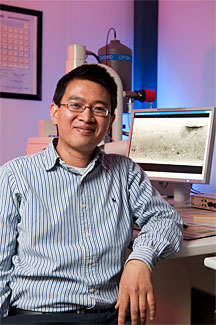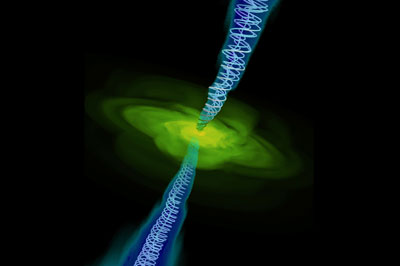 A team at DOE’s Fermi National Accelerator Laboratory achieved a record-high quality factor when testing the first fully dressed radio-frequency cavity built for a particle accelerator project at DOE’s SLAC National Accelerator Laboratory. The quality factor, Q, exceeded the goal for the Linac Coherent Light Source II project and far surpasses current state-of-the-art standards.
A team at DOE’s Fermi National Accelerator Laboratory achieved a record-high quality factor when testing the first fully dressed radio-frequency cavity built for a particle accelerator project at DOE’s SLAC National Accelerator Laboratory. The quality factor, Q, exceeded the goal for the Linac Coherent Light Source II project and far surpasses current state-of-the-art standards.
A higher Q means a cavity is more efficient at accelerating particles and loses less energy. It opens up a way for future particle accelerators to operate much more efficiently at a much lower cost.
LCLS-II will produce X-rays to probe a wide variety of materials at the nanoscale. Fermilab is responsible for designing, developing, building and testing about 150 nine-cell superconducting RF cavities for the LCLS-II accelerator. This was the first integrated test in which a nine-cell cavity was outfitted with all the components it will wear in the LCLS-II accelerator.
“This record Q is really the sum, the final point, of many years of research,” said Anna Grassellino, Fermilab Technical Division scientist who leads cavity testing and processing for LCLS-II.
SLAC physicist Marc Ross, LCLS-II cryogenics systems manager, says he’s pleased with the results. “It’s definitely a victory,” Ross said. “These are some of the highest-quality-factor practical resonators ever built.”
Grassellino led the Fermilab effort to apply the breakthrough technology, dubbed nitrogen doping, that helped achieve the record Q of 3.1 x 1010 at 2 Kelvin and at a 16-megavolt-per-meter peak surface electric field. It involves infusing nitrogen into a cavity’s inner niobium surface.
Nitrogen doping and other Fermilab discoveries that led to this Q value, such as the removal of magnetic flux through rapid cooling, will become new standards for achieving highly efficient accelerators worldwide.



